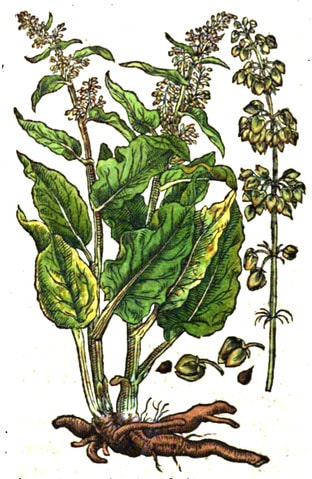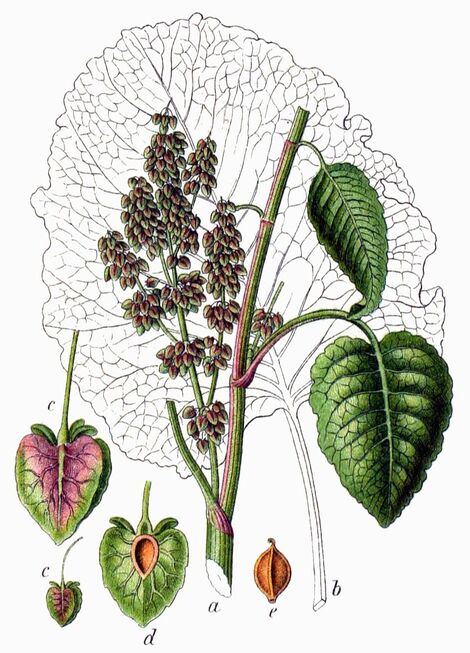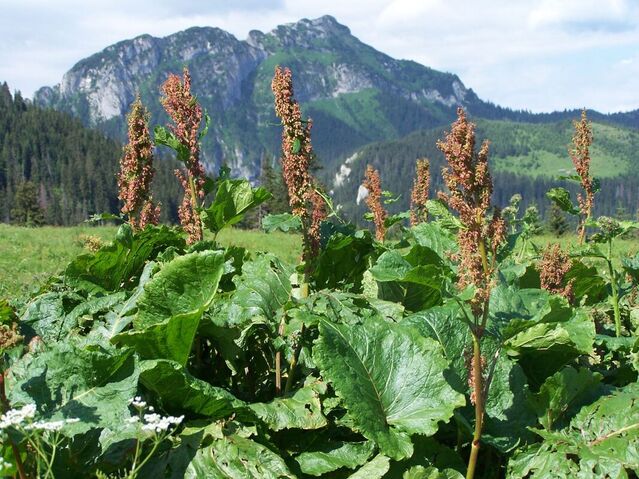Rhabarbari monachorum, Monk’s Rhubarb
Herb Patience, Hippolapathum, Lapanthus hortense, Rhubarbarum Monachorum
Kreutterbuch, Matthiolus, 1586
Deutschlands Flora in Abbildungen, Sturm, 1796
Botanical name:
Rumex alpinus
Parts used:
Root; the yellower the better
Temperature & Taste:
Cool (Neutral according to some) dry. Mildly Bitter
Classifications:
Aperitive, Abstersive, Astringent,
Rumex alpinus
Parts used:
Root; the yellower the better
Temperature & Taste:
Cool (Neutral according to some) dry. Mildly Bitter
Classifications:
Aperitive, Abstersive, Astringent,
Uses:
1. Purges Heat and Toxin:
-heat and toxin of the Blood; Scabs, Skin diseases, Leprosy
-used for acute diseases and Fevers with Heat and Toxin
-Diarrhea and Dysentery with Blood
-Venomous bites
-'tho' they have a Cathartic or Laxative force in loosening the belly ... they certainly bind after purging' (Salmon)
2. Opens Obstructions:
-Edema, Jaundice
3. Clears Heat, Stops Bleeding:
-Diarrhea and Dysentery with Blood, Blood in the Stool
-Hemoptysis
4. Externally:
-decocted in vinegar for skin diseases
-gargled for sore, ulcers of the mouth and throat, and for toothache
-distilled water of the whole plant is good to cleanse the skin of spots, pimples and skin diseases in general
Dose:
1. It can be used in twice–thrice the dose of regular Rhubarb
2. Seed and Root can be used in similar doses
3. Decocted in vinegar for Edema, Jaundice, Arthritis, Rhuematism, Stones etc.
Decoction: 6–15 (or more) grams
Powder: 3–6 grams
Comment:
1. It is used as true Rhubarb, but is milder in effect. Some preferred this for its gentler action except in cases where purging is required in which case true Rhubarb should be used. Its milder effect makes this more alterative to cleanse the Blood unless large doses are taken. Its dose is increased thrice to achieve effects similar to Rhubarb.
2. The leaves are eaten as a pot herb with salt and vinegar.
3. The Seeds are also used to stop leakage in Diarrhea and Dysentery, and for Spitting Blood. They also cure Nausea, Colic and loathing of food.
Preparation:
1. The roots can be roasted or charred to increase its effect of stopping Bleeding.
1. It can be used in twice–thrice the dose of regular Rhubarb
2. Seed and Root can be used in similar doses
3. Decocted in vinegar for Edema, Jaundice, Arthritis, Rhuematism, Stones etc.
Decoction: 6–15 (or more) grams
Powder: 3–6 grams
Comment:
1. It is used as true Rhubarb, but is milder in effect. Some preferred this for its gentler action except in cases where purging is required in which case true Rhubarb should be used. Its milder effect makes this more alterative to cleanse the Blood unless large doses are taken. Its dose is increased thrice to achieve effects similar to Rhubarb.
2. The leaves are eaten as a pot herb with salt and vinegar.
3. The Seeds are also used to stop leakage in Diarrhea and Dysentery, and for Spitting Blood. They also cure Nausea, Colic and loathing of food.
Preparation:
1. The roots can be roasted or charred to increase its effect of stopping Bleeding.
Main Combinations:
1. Acute Fever, Monk's Rhubarb with Blessed Thistle
2. Clear Heat and Toxin, and cleanse the Blood and Skin, Monk's Rhubarb with Violet
3. To Purge Heat and Phlegm, the powder is taken with Ginger
4. Spitting of Blood, Monk's Rhubarb with Gum Arabic
5. Edema, Jaundice, Rheumatism, Scrofula, Skin diseases:
I. Monk's Rhubarb with Madder, Senna, Agrimony, Licorice (Salmon, Botanologia)
II. Monk's Rhubarb, Scammony, Clove
Cautions:
None noted
Main Preparations used:
None noted
Main Preparations used:




